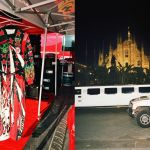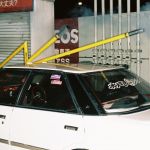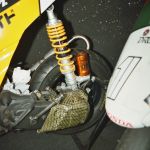
Drifting from Milan to Tokyo among tamarri and Bōsōzoku
A double interview with Toni Brugnoli and Federico Radaelli for the F.R.T.B. project
March 5th, 2021
Engines are not just a passion, but a way of life. In recent history, there have been numerous subcultures structured around the world of engines, especially around that of two wheels: the symbol of the English Mods was the Lambretta, that of the bikers the Harley-Davidson, that of the Paninari of Milan the Zündapp. More recent and varied, as well as less recognized, is another subculture: that of tuning. It is a subculture that revolves around the concept of customization, technical knowledge and, of course, speed – its members cultivate the passion and collecting of engines taking it to the next level and making themselves artisans and mechanics to transform their vehicle into an extension of themselves. All over the world, this subculture has a capillary and sometimes unconscious diffusion, develops around workshops (often leading to the birth of specialized workshops) and maintains, in a rather surprising way, a very precise aesthetic coherence that then obviously opens up to numerous local variations.
Toni Brugnoli and Federico Radaelli are two photographers who thought to document it for their photobook F.R.T.B., which tells the parallel stories of the tuning culture in Milan and the Bōsōzoku motorcycle aesthetic in Japan. nss magazine met them to talk about the genesis and nature of their project.
How did you meet and how did this project come about?
Federico: Tony I met him last summer, I needed a spare for the scooter I was processing at the beach (we are both sick for Honda God) and I was looking for this piece online on a forum, he kindly offered to give it to me and from there we met. We found that we were both photographers, that we had the same passions, interests, the same photo kit and shooting in a very similar way. If we decontextualize the photos it is very difficult to tell if a photo took him or I took it, this is a lot of fun and interesting. We only met once but we often feel and it's like we're longtime friends, that's because we've been to the same environments as kids.
Toni: After a few messages we realized that we had a lot in common, photography, engines, aesthetics... but the thing that surprised me was to review in Federico my own attitude in dealing with the photographic process.
Tuning is one of the last subcultures: how did you get passionate?
Tony: Tuning has always been my little obsession. I remember all the time I spent in my box in Lissone when I was a kid. My first scooter had nothing original, and in fact, you could see it! It was a lot if I could turn it on, who knows what mess I had done down there.
Federico: I see tuning as a hard and raw expression of the person, there is no shyness, there are no rules, there is a desire to be unique and to amaze.
Who are the guys who pick up the booster or the car today?
Tony: I don't think you can make a real category today. When I was a boy who liked his own vehicle was considered a tabbozzo, I was very happy with this thing. In short, the genuineness of this reality. In recent years this culture has been used a bit like all underground realities to create trends. All this, however, has a very positive side, a much more heterogeneous audience has become passionate about this aesthetic, which has thus had the opportunity to merge with different realities and visions.
Federico: they are the serious ones! And there are always a few, now 1000 euros are spent on a mobile phone but hardly in a car or motorcycle. I'm not saying we have to go back to the age of phone booths, but down there wants the right balance between living and living 2.0.
What are the differences and points in common between the bōsōzoku and tamarri of the Milan hinterland?
Tony: I think the big thing about these two realities is the desire to break the rules, to be a hooligan: it's a genuine, almost liberating feeling, a rebellious feeling. The roar of the drains, the speed, the sound of the horns, the chaotic colours of the livery... It is a way of life-giving voice to the streets of the city. It would be wrong to say that bōsōzoku are Japanese tamarri and vice versa because we are talking about two diametrically opposed cultures, but we can say that both have the same hooligan spirit that powers their engine.
Federico: I would say very few, both live by their means and spend every penny and free time in the care and customization of their means. These are some of the few subcultures left alive, unfortunately now with social media, there is a very strong tendency to homogenize people almost globally, and it is increasingly difficult to find unique and peculiar realities of specific places, especially in the new generations.
Better Milan or Tokyo? Tell us a little bit about these two cities.
Toni: Unfortunately I travel very little. Federico will surely give you a more comprehensive answer on this. But I can tell you that it's hard to compare two cities with such different cultures. It's like entering two parallel universes with touchpoints. Milan is a wonderful city. I grew up in the Milanese hinterland, in Lissone. I have always had the "myth" of Milan as a child, now that I live there and except area C there are no limits.
Federico: Japan and Tokyo are unique places, I lived there a part of 2019 and 2020. It was a great experience, I discovered a new world, where everything can amaze you. Education, civilization and friendliness are the cornerstones of Japanese people. I really miss Japan and my friends, I can't wait for this pandemic to be over or there will be a way to live with it but taking back our lives and habits.

Federico Radaelli
In recent years analogue aesthetics has become a trend: how will it evolve in the future?
Toni: I can say that personally analogue aesthetics has helped me so much in recent years to make my work more interesting to the public. I'm not hiding it, it's a very simple gimmick these days. I personally start to get a little bored with this language, but it's not that easy to change your approach to shooting. Then, honestly, the idea of having to select photos from a hundred digital shots already sends me anxious.
Federico: I hope more and more people will continue to shoot in film and keep this market alive, I very much hope that Kodak and the major brands will stop this continuous increase in roller costs. I find the prices of now unacceptable and certainly do not help artists or people who cultivate this passion with their savings. This is the only snag I see in the evolution of analogue aesthetics, I personally bought a new digital camera with which I am having a lot of fun exploring its potential.












































































